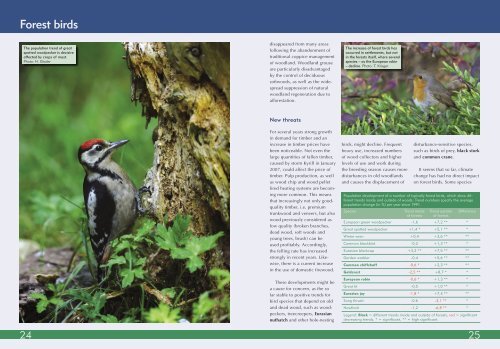Birds and Biodiversity in Germany - Bundesamt für Naturschutz
Birds and Biodiversity in Germany - Bundesamt für Naturschutz
Birds and Biodiversity in Germany - Bundesamt für Naturschutz
You also want an ePaper? Increase the reach of your titles
YUMPU automatically turns print PDFs into web optimized ePapers that Google loves.
Forest birds<br />
The population trend of great<br />
spotted woodpecker is decisive<br />
affected by crops of mast.<br />
Photo: H. Glader<br />
disappeared from many areas<br />
follow<strong>in</strong>g the ab<strong>and</strong>onment of<br />
traditional coppice management<br />
of woodl<strong>and</strong>. Woodl<strong>and</strong> grouse<br />
are particularly disadvantaged<br />
by the control of deciduous<br />
softwoods, as well as the widespread<br />
suppression of natural<br />
woodl<strong>and</strong> regeneration due to<br />
afforestation.<br />
New threats<br />
For several years strong growth<br />
<strong>in</strong> dem<strong>and</strong> for timber <strong>and</strong> an<br />
<strong>in</strong>crease <strong>in</strong> timber prices have<br />
been noticeable. Not even the<br />
large quantities of fallen timber,<br />
caused by storm Kyrill <strong>in</strong> January<br />
2007, could affect the price of<br />
timber. Pulp production, as well<br />
as wood chip <strong>and</strong> wood pellet<br />
fired heat<strong>in</strong>g systems are becom<strong>in</strong>g<br />
more common. This means<br />
that <strong>in</strong>creas<strong>in</strong>gly not only goodquality<br />
timber, i.e. premium<br />
trunkwood <strong>and</strong> veneers, but also<br />
wood previously considered as<br />
low quality (broken branches,<br />
dead wood, soft woods <strong>and</strong><br />
young trees, brush) can be<br />
used profitably. Accord<strong>in</strong>gly,<br />
the fell<strong>in</strong>g rate has <strong>in</strong>creased<br />
strongly <strong>in</strong> recent years. Likewise,<br />
there is a current <strong>in</strong>crease<br />
<strong>in</strong> the use of domestic firewood.<br />
These developments might be<br />
a cause for concern, as the so<br />
far stable to positive trends for<br />
bird species that depend on old<br />
<strong>and</strong> dead wood, such as woodpeckers,<br />
treecreepers, Eurasian<br />
nuthatch <strong>and</strong> other hole-nest<strong>in</strong>g<br />
The <strong>in</strong>crease of forest birds has<br />
occurred <strong>in</strong> settlements, but not<br />
<strong>in</strong> the forests itself, where several<br />
species – as the European rob<strong>in</strong><br />
– decl<strong>in</strong>e. Photo: T. Krüger<br />
birds, might decl<strong>in</strong>e. Frequent<br />
heavy use, <strong>in</strong>creased numbers<br />
of wood collectors <strong>and</strong> higher<br />
levels of use <strong>and</strong> work dur<strong>in</strong>g<br />
the breed<strong>in</strong>g season causes more<br />
disturbances <strong>in</strong> old woodl<strong>and</strong>s<br />
<strong>and</strong> causes the displacement of<br />
Population development of a number of typically forest birds, which show different<br />
trends <strong>in</strong>side <strong>and</strong> outside of woods. Trend numbers specify the average<br />
population change (<strong>in</strong> %) per year s<strong>in</strong>ce 1991.<br />
Species Trend <strong>in</strong>side<br />
of forests<br />
disturbance-sensitive species,<br />
such as birds of prey, black stork<br />
<strong>and</strong> common crane.<br />
It seems that so far, climate<br />
change has had no direct impact<br />
on forest birds. Some species<br />
24 25<br />
Trend outside<br />
of forests<br />
Difference<br />
European green woodpecker -1,6 +7,2 ** *<br />
Great spotted woodpecker +1,4 * +5,1 ** *<br />
W<strong>in</strong>ter wren +0,4 +3,6 ** **<br />
Common blackbird -0,2 +1,3 ** *<br />
Eurasian blackcap +3,2 ** +7,5 ** **<br />
Garden warbler -0,4 +5,6 ** **<br />
Common chiffchaff -0,6 * +2,3 ** **<br />
Goldcrest -2,5 ** +8,7 * *<br />
European rob<strong>in</strong> -0,6 * +1,3 ** *<br />
Great tit -0,5 +1,0 ** *<br />
Eurasian jay -1,8 * +7,4 ** **<br />
Song thrush -0.6 -3,1 ** *<br />
Hawf<strong>in</strong>ch -1,2 -6,8 ** *<br />
Legend: Black = different trends <strong>in</strong>side <strong>and</strong> outside of forests, red = significant<br />
decreas<strong>in</strong>g trends, * = significant, ** = high significant.

















